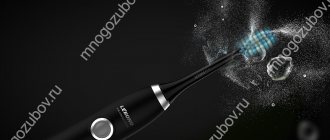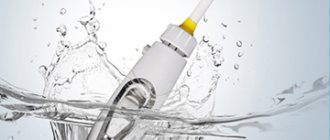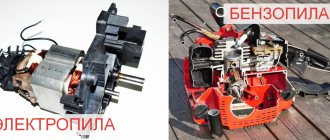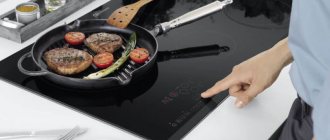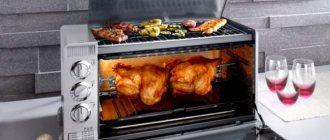In this article
- How does an electric toothbrush work?
- Design features and operating principle of the irrigator
- Irrigator or brush: is it worth choosing?
- What is better - a waterpik or a toothbrush?
When thinking about quality oral hygiene, many people ask the question: which is better - a waterpik or an electric toothbrush? To answer this question, you first need to understand how both of these devices work and what problems they solve.
How does an electric toothbrush work?
An electric brush is a more technologically advanced version of a regular toothbrush. It is a tool for primary oral hygiene, helps remove food debris from the surface of the teeth, clean the enamel from soft and hard plaque.
The difference between an electric brush and a regular toothbrush is the vibration of the bristles, which is provided by the operation of an electric motor. Most often, the motor is built into the handle of the device and is powered by batteries or a rechargeable battery.
The bristles of an electric toothbrush can move in different directions - in a circle or up and down, effectively softening and removing mineral plaque.
Electric toothbrushes are divided into different types based on the speed of movement of the bristles.
- Sound model.
It cleans the surface of the teeth thanks to a combination of sound waves and vibrations of the bristles with a certain amplitude. Such a device makes more than 20 thousand movements per minute and, with the help of friction, even removes plaque, preventing it from hardening and forming deposits on the teeth. Using sound models with different attachments helps keep teeth clean and prevents the formation of stones.
- Ultrasonic toothbrush.
It creates an ultrasound wave that is inaudible to the human ear, so it works almost silently, but provides high quality teeth cleaning. An ultrasonic brush not only effectively removes large stains, but also has a destructive effect on bacteria that form plaque on teeth. It copes with soft and pigmented plaque, promotes better penetration of cleaning pastes into the tissues of the oral cavity.
Most models have power regulators and several operating modes, which makes their use as convenient and comfortable as possible. Among the disadvantages, one can note a rather rough effect on crowns, veneers and fillings, which can lead to their early wear and destruction.
Model overview
Below are the models of irrigators and electric toothbrushes:
WaterPik WP-70 Classic
Irrigator with five modes. There is a button on the body designed to change the speed. The pulsation frequency reaches 1200 pulses per minute, the water pressure is supplied under a pressure of 35-550 kPa. The irrigator is equipped with 4 protective attachments. Powered by mains power. The user has the opportunity to hang the device on the wall for comfortable work. The container volume is one liter.
The advantages of the WaterPik WP-70 Classic irrigator include thorough cleaning of the oral cavity, a neat and aesthetic design, and a large water tank. The disadvantages of the model are considered to be heavy weight, loud noise during operation, and splashing of water during use.
Oral-B Professional Care OxyJet + 3000
Dental center (irrigator), powered from the mains. The user can independently set one of five speeds. The device comes with 10 convenient attachments. Teeth cleaning is carried out using microbubbles.
Manufacturers have provided a special pressure sensor that lights up when there is excessive pressure during cleaning. The irrigator begins to vibrate every half a minute after 2 minutes have passed so that the time required for cleaning is not exceeded. The volume of the water/solution reservoir is 0.6 ml.
Advantages of the Oral-B Professional Care OxyJet + 3000 irrigator
- strong and adjustable set;
- high-quality teeth cleaning and gum massage;
- compactness;
- long-term operation without charging;
- excellent modern design;
- ease of use;
- functionality.
Many users consider the disadvantages of the lack of some types of attachments, high cost, and noisy operation.
ORAL-B PROFESSIONAL CARE 5000 D34
The electric toothbrush is equipped with four heads with multi-colored rings. This is especially convenient when all family members use the same brush.
The device is also equipped with a whitening attachment designed to lighten tooth enamel. A special feature of this attachment is the presence of soft polishing inserts - this reduces the risk of harm to tooth enamel and ensures effective removal of darkened areas. Manufacturers have taken care of the speed modes - there are 5 of them, including a whitening, massage and delicate cleaning mode.
This model has a pressure sensor, due to which you can control the degree of pressure of the bristles on the tooth enamel. There is also a display that displays various information regarding the charge level, cleaning, reminder to change the nozzle, etc.
The disadvantages of ORAL-B PROFESSIONAL CARE 5000 D34 include its excessively high cost.
CS MEDICA CS-262
An electric toothbrush, considered one of the budget sonic models. The low cost of the device is due to the fact that the brush runs on regular batteries. On the one hand, this is a drawback, because you will have to regularly spend money on purchasing consumables for high-quality work. But on the other hand, this model has many advantages:
- Ease of use. You can always replace the batteries if the device does not work. A battery-powered model will have to be charged for several hours. This is not so convenient when you are short on time.
- A light weight. Battery-powered toothbrushes are several times lighter than their rechargeable counterparts.
- Duration of work. Manufacturers claim that the device can operate for 150 hours on two batteries.
- Availability of attachments. The device is equipped with two nozzles, which will be ideal for a married couple.
- Whitening mode. It will be possible to more carefully clean tooth enamel, restoring an attractive snow-white smile.
Users of the CS MEDICA CS-262 sonic brush note that the device is inexpensive and convenient to use due to its light weight (weighs only 45 grams).
Design features and operating principle of the irrigator
Both brushes and irrigators are designed for oral hygiene. But these devices are not identical in their purpose. If an electric toothbrush is a primary hygiene item, then an irrigator is a secondary item. This means that any cleaning should begin with the use of a brush, which removes the main contaminants, and only then can you proceed to cleansing the oral cavity with an irrigator. It does not replace a toothbrush, but helps to bring the cleaning result to perfection. How does this device work and work?
It is a device that delivers a directed stream of pulsating water under pressure into the oral cavity. Contacting the teeth and gums, the jet cleans well those areas where the brush cannot reach. Using an irrigator, it is convenient to clean the interdental spaces without traumatizing the gums, take care of braces, implants, dentures, and wash away food debris and dirt from gum pockets and from under dental structures.
The irrigator acts on the gums much more delicately, provides a gentle massage, improves blood flow, and strengthens the gums. Since the irrigator can remove dirt even from difficult areas, there are almost no germs left in the oral cavity, which effectively solves the problem of unpleasant odor.
Dentists recommend using this device to everyone who cares about the health of their teeth, but especially to people with sensitive gums and those who wear dental appliances.
Despite the advantages of this device, it cannot be said that the irrigator is better than an electric toothbrush. It cannot be a full-fledged replacement, since a stream of water does not provide a 100% mechanical cleaning effect. The device cannot completely remove complex plaque and tartar; a brush and paste are needed to solve this problem. But as complementary hygiene products, a water flosser and an electric toothbrush work very effectively.
Irrigator
Purpose
Despite the fact that this instrument for cleaning the oral cavity was invented in the middle of the last century, it is still not widely popular among us. But in vain, because it helps to thoroughly clean the spaces between the teeth, which a toothbrush cannot reach. In addition, it removes plaque and food debris, preventing the formation of tartar. This partially solves the issue of gum health. Massage, which is performed using a stream of water or medicinal liquid, makes them stronger.
Using the device, they clean the tongue, penetrate into the gum pockets, removing food debris and bacteria accumulated there. Its use is especially indicated for people who have bridges, crowns, removable structures and braces installed.
Irrigator or brush: is it worth choosing?
If the choice is “irrigator or electric brush,” many will prefer the latter, since it is an item of primary hygiene.
There is still an opinion that it is not necessary to use an irrigator, and for good hygiene it is enough to choose a good brush.
In fact, it is wrong to put yourself before the choice of “irrigator or electric toothbrush.” Just as the first cannot replace the second, the brush cannot effectively cope with the tasks that the irrigator solves.
The bristles cannot fully clean the interdental spaces or remove food debris from under bridges and other orthopedic and orthodontic structures. The brush is not able to provide useful hydromassage for the gums, which serves as a prevention of bleeding, periodontal disease, and inflammatory processes. Even the best quality brush cannot clean your braces as well and as carefully as a pulsating stream of water will.
Dentists are sure: there is no need to choose what works best. The best option is to use all available means for hygiene of teeth and gums.
By using an irrigator, toothbrush and floss at the same time to care for the oral cavity, you can achieve maximum cleaning results, ensure healthy teeth and gums, and prevent the development of a number of dental diseases. It is important to use the available tools in the correct order.
- The first stage is mechanical cleaning with a brush and paste.
- The second is to use dental floss to remove dirt from between teeth. If you have sensitive gums that immediately bleed from contact with the thread, then you can abandon the second stage and immediately move on to the next one.
- The third stage is cleaning with an irrigator. When the main contaminants have been removed, it's time to begin the final procedure. The water jet penetrates into hard-to-reach areas and removes all remaining dirt, ensuring impeccable oral hygiene.
Daily care of teeth and gums
It is known that the more carefully we take care of our teeth at home, the less money we will spend on dental services in the future. But for high-quality prevention of diseases of teeth and gums, it is not enough to use only an electric or ultrasonic toothbrush and toothpaste. The care should be complemented by stationary irrigators - modern high-tech devices that help, using water pressure, to care for the oral cavity and clean the interdental spaces.
What is better - a waterpik or a toothbrush?
The very formulation of the question - “brush or irrigator” - is incorrect. You can compare devices that have a similar operating principle or perform the same functions. The design and operating features of a brush and a dental irrigator are different. An irrigator does not replace a brush; these devices solve different dental problems in different ways. Therefore, it is wrong to say that it will be better to clean your teeth. The best option is comprehensive cleaning using an irrigator and a high-quality electric toothbrush.
Please note that these devices may be contraindicated for people with certain dental diseases and conditions. Therefore, before the first use, it is advisable to visit a dentist, check the condition of the oral cavity and, together with a professional, select the optimal hygiene care regimen.
Can one replace the other?
The key tool for oral care is an electric toothbrush. Additional tools and innovative devices can improve the quality of cleaning the oral cavity, teeth, the space between them, gums and the surface of the tongue.
An irrigator cannot completely replace a brush. The devices differ in purpose, but can be combined with each other, thereby improving the quality of cleaning and keeping teeth healthy.
Using an irrigator cannot replace constant cleaning with electrical appliances. To preserve dental health, it is recommended to use comprehensive care products. That is, use not only a brush and irrigator, but also floss and a special tongue scraper.
Cons of an electric toothbrush
- May loosen teeth.
- Provokes separation of enamel from the gums.
- Increases sensitivity.
- Increases the chance of caries.
- The duration of the procedure is at least 10 minutes.
You cannot replace brushing with an irrigator. It is only an additional feature that gets rid of food residues in hard-to-reach places.
Varieties
Depending on the type of food:
- From the battery, which is recharged from the stand included in the kit.
- Battery operated - perfect for people who travel frequently.
In the direction of movement of the head bristles:
- The bristles move from one side to the other.
- The bristly head rotates around its axis.
- The bristles move in different directions.
- The villi move with accompanying vibration.
- The entire brush vibrates.
How to use an irrigator correctly
An irrigator is a device for cleaning teeth that can be used even by children over the age of 6 years. Orthodontists recommend this device to those who wear braces because orthodontic appliances are much easier to clean with a pulsating stream of water than with floss. Periodontists advise using an irrigator to carry out hygiene of periodontal pockets, as well as to improve blood circulation in the gums. Hygienists find this device to be a good way to maintain oral hygiene until your next professional teeth cleaning. Orthopedists recommend using an irrigator if there is an implant-supported structure in the oral cavity.
These specialists will tell you during your appointment how to use the irrigator correctly and how often. But there are a few rules that everyone should follow:
- Teeth and gums do not immediately get used to the sensations caused by a pulsating stream of water. Therefore, at first it is better to make the liquid pressure weak, and as you get used to it, increase it.
- Dentists recommend starting the procedure from the upper jaw, and first of all it is better to pay attention to the teeth in the smile area, and only then move on to the molars.
- Everything needs to be cleaned: the outer and inner sides of the teeth and gums, the spaces between the teeth, the periodontal pockets.
An irrigator is a device that helps fight bacteria and plaque. But it cannot destroy tartar or protect against tooth decay. Therefore, even if you have a comprehensive approach to home oral hygiene, once every 6 months you still need to come for a preventive examination to a dentist-therapist and for professional oral and dental hygiene to a hygienist.
Commenting system SigComments
Back to section
